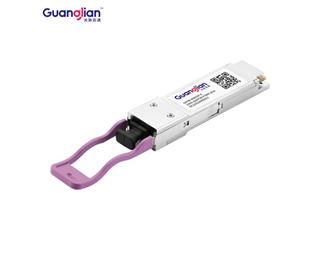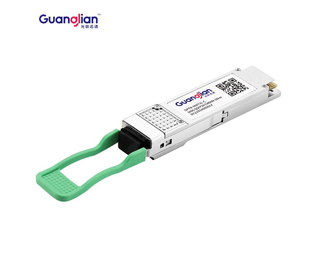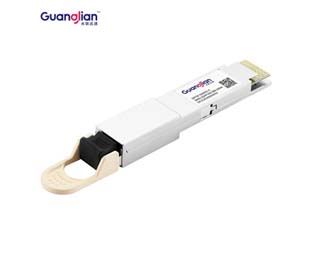The last few years have seen the emergence of various optical module form factors as new technologies and high-speed interconnects have evolved, with the QSFP56, a member of the QSFP family, being the solution for 200G applications. What is the difference between the QSFP56 and other QSFP family form factors, and is the QSFP56 the same as the QSFP56-DD? If you are confused about these questions, then this article is for you.
In order to understand what the QSFP56 is, let's first look at the QSFP form factor. Because it represents up to four wavelengths, it offers higher bandwidth capacity than SFP modules.
The 40G QSFP+, which evolved from the QSFP, was born, followed by the 100G QSFP28 for high-density applications. As data traffic rises in data centers and advanced networking applications, there is an urgent need to achieve higher speeds for general availability. additional additions to the QSFP family of form factors are available, such as the 200G QSFP56 and 400G QSFP56-DD.
100GBASE-QSFP28-PSM4-500m/2km Optical Transceiver Module
An evolution of the previous 40G QSFP+ and 100G QSFP28, the Quad 50 Gb Small Form Factor Pluggable (QSFP56) is designed for 200G Ethernet. QSFP56 modules are similar to QSFPs in terms of size and form factor. QSFP56 modules are classified by distance as QSFP56 CR, SR, DR, FR, LR, and can be implemented over single-mode fiber (SMF) or multimode fiber (MMF) at different transmission distances.
Generally, two QSFP56 modules with one SMF or MMF can achieve a 200G link. QSFP56 AOC/DAC is also a way to achieve a 200G link by connecting the QSFP56 ports on two devices in a simplified link process. For bridging 200G QSFP56 ports with other speeds, there is a 200G QSFP56 to 2x100G QSFP28 branch cable and a 200G QSFP56 to 4x50G SFP56 branch cable to enable 2x100G or 4x50G connectivity.
From their industry names, QSFP56, QSFP28, and QSFP+ are very similar because they share the same QSFP form factor, as indicated by their suffixes, and they have the same dimensions. However, their data center and connectivity capabilities are different.
Compared to the QSFP+ and QSFP28, the QSFP56 form factor offers higher network speeds than the 200G QSFP, which supports 4×50G channels. The QSFP+ is an evolution of the QSFP, supporting 4 x 10G channels carrying 10G Ethernet, 10G Fibre Channel, or QDR InfiniBand. it introduces the concept of multiplexing four channels to increase bandwidth and is capable of handling 40Gbps line rates at 10GBaud NRZ per channel. the QSFP28 supports 4 x 25G channels and, like the QSFP+, contains a 4-channel optical transmitter and a 4-channel optical receiver.
200G QSFP56
The most significant change from the QSFP+ and QSFP28 to the QSFP56 is that the QSFP56 undergoes a change from NRZ encoding to PAM4 encoding. While the QSFP56 still uses 4 channels as QSFP28, the modulation is doubled to 50G per channel, allowing for more data on existing fiber and therefore better suited for hyperscale data center networks.
With the rapid growth of data centers, the need for ever-increasing data volumes is driving network components to support higher bandwidth and higher density. The latest iteration of the optical module form factor is from the QSFP56 to the QSFP56-DD, also known as the 400G QSFP-DD. DD here refers to double density and indicates 400G (using 50G PAM4) by doubling the data lanes of the QSFP56 from 4 to 8 lanes.
The QSFP56-DD, while having double density, is similar in size to the QSFP56. 400G QSFP56-DD ports are backward compatible with QSFP transceivers, meaning that the QSFP56 can work on QSFP56-DD ports as long as the switch supports it. When using a QSFP56 module in a QSFP56-DD port, the port will be configured for 200G data rates instead of 400G.
The QSFP56-DD form factor is now recognized by the 400G market as the most popular 400G form factor. While 400G Ethernet is seen today as the future-proof solution for next-generation data centers, some organizations deploying 200G Ethernet still require the 200G QSFP56.
100G CFP vs QSFP28: Which One to Choose?
Jun. 11, 2022What Makes the Best Optical Transceiver Module?
May. 27, 2022200G QSFP56 Optical Module Knowledge Full Explanation
Apr. 25, 2022
100G CFP vs QSFP28: Which One to Choose?
Jun. 11, 2022
What Makes the Best Optical Transceiver Module?
May. 27, 2022Copyright ©Guanglian Xuntong Technology Group Co., Ltd. All Rights Reserved | Sitemap
